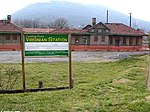Riverland Historic District

The Riverland Historic District encompasses an early 20th century neighborhood on the south side of the Roanoke River in Roanoke, Virginia. The area consists of a portion of the residential area bounded on the south by Walnut Avenue SE, on the east by Arbutus Avenue SE, and on other sides by the river. Most of the included properties are either on Arbutus Avenue or Riverland Street, with some also on Piedmont Street and Walnut Avenue. The neighborhood is one of closely spaced residential properties built to provide housing for workers in nearby businesses. It was developed by the Highland Land Company, and was mostly built out between 1900 and 1930.The district was listed on the National Register of Historic Places in 2013.
Excerpt from the Wikipedia article Riverland Historic District (License: CC BY-SA 3.0, Authors, Images).Riverland Historic District
Laurel Street Southeast, Roanoke Morningside
Geographical coordinates (GPS) Address Nearby Places Show on map
Geographical coordinates (GPS)
| Latitude | Longitude |
|---|---|
| N 37.258462 ° | E -79.934145 ° |
Address
Laurel Street Southeast 1015
24014 Roanoke, Morningside
Virginia, United States
Open on Google Maps






